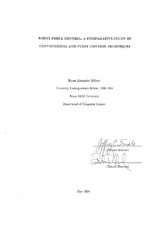| dc.contributor.advisor | Trinkle, Jeffrey C. | |
| dc.creator | Bilbrey, Bryan Alexander | |
| dc.date.accessioned | 2022-04-01T15:11:28Z | |
| dc.date.available | 2022-04-01T15:11:28Z | |
| dc.date.issued | 1994 | |
| dc.identifier.uri | https://hdl.handle.net/1969.1/CAPSTONE-BilbreyB_1994 | |
| dc.description | Program year: 1993/1994 | en |
| dc.description | Digitized from print original stored in HDR | en |
| dc.description.abstract | In order to provide the CS Robotics Lab with a functional tool in the form of an instrumented compliant wrist two main goals were identified for completion during the 1993-1994 school year. The first goal, the acquisition of an accurate representation of the wrist’s force-to-deflection relationship in the form of a stiffness matrix, was performed via calibration. The second goal was the implementation of a conventional hybrid position/force controller using the compliant wrist. Calibration of the wrist and the implementation of a conventional force controller using the wrist are significant in that they allow for study of hybrid position/force control using compliance by the CS Robotics Lab; both areas of active research within the robotics community. Given the calibration and implementation of the wrist, a secondary goal of implementing a fuzzy hybrid position/force controller and performing a comparative study between conventional and fuzzy control techniques was identified.
To date, due mainly to hardware problems, the calibration of the compliant wrist has not been successfully completed and implementation of a conventional hybrid position/force controller utilizing the theoretically calculated stiffness matrix of the wrist is only partially complete. Although work has begun on a fuzzy logic based hybrid position/force controller and this subject still holds much fascination for me, I have not been able to devote sufficient time to it’s implementation to result in a working fuzzy position/force controller 1.
In this document an explanation of the compliant wrist, a method for calibrating the wrist and methods for implementing conventional and fuzzy hybrid position/force controllers using the wrist are presented. Along with the overall results of this year’s work, a comparison of both controllers is presented, followed by a section detailing where future work in the areas of compliance and fuzzy hybrid position/force control might lie. | en |
| dc.format.extent | 40 pages | en |
| dc.format.medium | electronic | en |
| dc.format.mimetype | application/pdf | |
| dc.subject | robotics | en |
| dc.subject | compliant wrist | en |
| dc.subject | hybrid position/force controllers | en |
| dc.subject | control techniques | en |
| dc.title | Robot Force Control: A Comparative Study of Conventional and Fuzzy Control Techniques | en |
| dc.title.alternative | Robot Force Control: A Comparative Study of Conventional and Fuzzy Control Techniques | en |
| dc.type | Thesis | en |
| thesis.degree.department | Computer Science | en |
| thesis.degree.grantor | University Undergraduate Fellow | en |
| thesis.degree.level | Undergraduate | en |
| dc.type.material | text | en |


